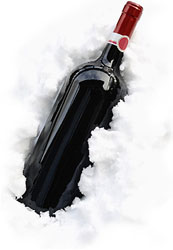 [Editor’s Note: For those of you not familiar, an ice wine is a wine made from the juice of frozen grapes. Most of the water in the grapes is frozen but the sugar is not. When a winery runs them through the grape crusher and grape presses, the result is a very, very sweet grape juice that will make a wine with high alcohol and a lot of flavor.]
[Editor’s Note: For those of you not familiar, an ice wine is a wine made from the juice of frozen grapes. Most of the water in the grapes is frozen but the sugar is not. When a winery runs them through the grape crusher and grape presses, the result is a very, very sweet grape juice that will make a wine with high alcohol and a lot of flavor.]
———-
Hi,
I have some lake niagara grapes that I am interested in trying to make an ice wine recipe. They are in the freezer currently. Do I make it the same as a grape wine or is there some other step in the process that I have to do? Any info you can give me would be appreciated.
Thanks,
Mark O.
———-
Dear Mark,
What you are actually attempting to make is an icebox wine not an ice wine. The difference being, you are using artificial cold to freeze the grapes as opposed to leaving them on the vine and waiting for Mother Nature to do the freezing for you.
To answer your question, there is really not too much difference between making an ice wine and making any other grape wine. The basic steps are the same, except for the fact that you will be putting the grapes through a grape crusher and your grape presses before fermentation. The skins will not be in the fermenter at all. This is because the ice is with the pulp at this point.
The whole goal with ice wines is to get as much sugar out of the grapes while getting as little of the water. Freezing the grapes works out good for this purpose. Water freezes at a higher temperature than sugar does, a phenomenon known as fractional crystallization.
By bringing the grapes down in temperature to around 15F. to 20F. you are freezing mostly water. The grapes are then ran through the grape crusher and pressed as quickly as possible. An extremely sweet juice comes out of the press while the skins, pulp and ice stay in the press and are later discarded.
Having a refractometer to monitor the sugar concentration of the grape juice at this stage would be beneficial. You are looking to get a brix reading of at least 35 degrees. This is the minimal level used by commercial wineries in Canada — Canada being the biggest produce of ice wine in the world.
I hope this information helps you out. Just remember that it is really no different than how to make white wine, only the grapes are cold and stiff.
Best Wishes,
Customer Service
———————————————————————————————————
Ed Kraus is a 3rd generation home brewer/winemaker and has been an owner of E. C. Kraus since 1999. He has been helping individuals make better wine and beer for over 25 years.
One Packet Of Wine Yeast Is All It Takes!
 I was going over Friday’s post, and it came to mind that the information in that post about a little yeast creating a lot of sediment actually relates to one of our wine making tips. Even though it is hard to put too much yeast in a batch of wine, the opposite holds true as well:
I was going over Friday’s post, and it came to mind that the information in that post about a little yeast creating a lot of sediment actually relates to one of our wine making tips. Even though it is hard to put too much yeast in a batch of wine, the opposite holds true as well:
Regardless if you’re making 1 gallon or 5 gallons of wine, only 1 packet of wine yeast is needed.
What this is saying is if you have a 1 gallon wine recipe that you are following, and it calls for 1 packet of wine yeast for that gallon of wine, and you want to make 3 gallons, multiply all the ingredients by 3 except for the yeast. One packet will be plenty regardless if you are making 1 or 3 gallons.
The only time you will need to add more than a single packet is if the batch is more than six gallons. For every 6 gallons you will need an additional packet of wine yeast. As an example, if you are making 20 gallons of wine you will need to add four packets of yeast.
Another way to look at this is to think of the yeast as a starting culture not as an amount to be related to a recipe. As long as you are adding enough to sustain the culture in the batch, you are adding plenty.
———————————————————————————————————
Ed Kraus is a 3rd generation home brewer/winemaker and has been an owner of E. C. Kraus since 1999. He has been helping individuals make better wine and beer for over 25 years.
Where Did All That Sediment Come From?
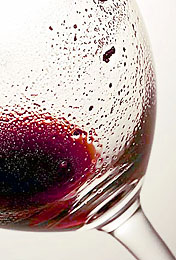 Have you ever wondered where all the sediment in the bottom of your fermenter comes from?
Have you ever wondered where all the sediment in the bottom of your fermenter comes from?
We’re not talking about the strands of pulp and other bits of the fruit, but that creamy, brown-looking stuff at the very bottom. Is it the broken-down solid remnants of the fruit? No, it even shows up when you make your wine from pulp-free concentrates! Could it be sugar that was added to the juice? No, the sediment’s there even when no sugar at all has been added to the must. So what is it? Where did it come from?
Here’s A Shocker. Remember back when you started the wine and you were adding all the wine making ingredients, just like the homemade wine instructions said to do? One of the ingredients that you added was in a little foil packet about 1-1/2 inches square–the wine yeast. That little packet is what produced all that sediment.
Once the yeast begin to ferment, they start multiplying by a process known as budding. In fact, in a 5 or 6 gallon batch of wine, the wine yeast will typically multiply themselves by about 100 to 150 times the little packet you added. This means you could have well over a pound of sediment just from the yeast alone. Wow, that’s freaky!
Well It Gets Freakier: Even if you add two packs of wine yeast you do not get two times the sediment. You will get more for sure, but only a minor, marginal amount. This is the nature of wine yeast. It propagates itself only to the level necessary to complete the fermentation.
This makes it near impossible to add too much wine yeast. Whether you add one, two or three packs to a 5 or 6 gallon batch of wine, the results are virtually the same.
So now you know…
———————————————————————————————————
Ed Kraus is a 3rd generation home brewer/winemaker and has been an owner of E. C. Kraus since 1999. He has been helping individuals make better wine and beer for over 25 years.
Will Wine Conditioner Stop My Wine From Fermenting Again?
Hello Kraus,
I made my first batch of homemade blackberry wine and it was too dry, so I put in a bottle of your Wine Conditioner, tried it and it was still too dry. So my question to you is if I mixed up some sugar water and put it in would it re-ferment again or not .
Thanks Bill
———-
Dear Bill,
Wine Conditioner is one of those wine making products that makes the winemaker’s job so much easier. It is fructose and glucose sugars that have had Potassium Sorbate added to them. The Potassium Sorbate acts as a stabilizer that will keep the wine from fermenting again with the newly added sugars from the Wine Conditioner.
The amount of Potassium Sorbate needed to keep a wine stable is not dependent on the amount of sugar that has been added to the wine. It is dependent on the volume of wine that is being stabilized. In the case of Wine Conditioner, as long as you have added 1/3 of the bottle to a 6 gallon batch, there is enough Potassium Sorbate in the wine to keep it completely stable regardless of how much sugar you add.
So to answer your question, you can add all the sugar syrup mix you like without worrying about a re-fermentation because of the Potassium Sorbate you’ve already added by way of the Wine Conditioner. This is one of those neat, little wine making tips for the home winemaker who is trying to economize a little bit. As long as enough Wine Conditioner is used, you will not have any issues with re-fermentation.
I would like to point out here that wine making products such as Wine Conditioner are made specifically for wine. The fructose and glucose sugars sweeten the wine differently than regular, store-bought cane sugar does. This is something you need to keep in mind when deciding whether or not to utilize economizing wine making tips such as this one. Flavor may be an issue.
Best Wishes,
Customer Service at E. C. Kraus
———————————————————————————————————
Ed Kraus is a 3rd generation home brewer/winemaker and has been an owner of E. C. Kraus since 1999. He has been helping individuals make better wine and beer for over 25 years.
Does Bottled Water Need Sodium Metabisulfite Added?
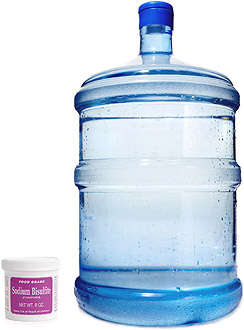 Hello:
Hello:
I recently read an article on your website that said not to use distilled water, but bottled water labeled spring water. Should I treat the water with sodium metabisulfite before beginning the primary fermentation in my plastic fermenter or is the bottled spring water okay to use straight from the bottle?
-Shawn S.
———-
Dear Shawn,
Deciding if you should add Sodium Metabisulfite before the fermentation or not isn’t determined by the type of water you use. Regardless if it is bottled spring water or just plain tap water, it does not make a difference. Either water is fine and does not require the addition of sulfites.
What does matter is whether or not you are making wine from fresh fruits. When making wine from fresh fruits, sulfites should be added before the fermentation to destroy any wild molds, bacteria, etc. If you are making wine from a packaged wine making juice of some kind, then there are no wild molds or bacteria to be delt with, so no sulfites are needed.
Sodium Metabisulfite is added 24 hours before you add the wine yeast. During this time the sulfites release into the must and then slowly disipate into the air. This is why you only want the fermenter to be covered with nothing more than a light towel. Once 24 hours has past, you can then add your wine yeast. If you add the yeast before this time, you run the risk of killing the yeast with the sulfites.
Best Wishes,
Customer Service
———————————————————————————————————
Ed Kraus is a 3rd generation home brewer/winemaker and has been an owner of E. C. Kraus since 1999. He has been helping individuals make better wine and beer for over 25 years.
Preparing A Wine For Longer Aging
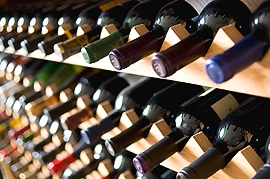 Dear Friends,
Dear Friends,
What do I have to do to age my wine longer than the time the instruction say. For example I drink some at the time it is ready by instruction and save some for tasting later and see if is getting any better by aging.
Thank You
Ricardo
———-
Dear Ricardo,
There are two basic things that you will need to do to get a wine ready for extended aging.
1) Add Sodium Metabisulfite To The Wine: This will help keep the wine from spoiling and also keep the wine’s color fresh and brilliant. Wines that are not treated with Sodium Metabisulfite run a risk of slowly turning to vinegar over time.
It should be added to the wine right before bottling. It comes in a granulated form and is vary easy to dissolve into the wine. The dosage is small, 1/16 of a teaspoon for each gallon of wine or 1 teaspoon for every 16 gallons of wine.
2) Use A Good Wine Bottle Cork: The longer you plan on aging the wine the better the wine cork should be. Our Superior Grade Straight Corks will work fine for wines that will be consumed within three years time. If you plan on aging you wine longer than this, then you might want to buy corks that are even more dense such as our Extra First Grade Corks or Synthetic Corks.
You will need a corker to insert any of these corks into the wine bottle. This is because their diameter needs to be compressed down to the size of the wine bottle’s opening and then plunged into the opening of the bottle.
Best Wishes,
Customer Service
———————————————————————————————————
Ed Kraus is a 3rd generation home brewer/winemaker and has been an owner of E. C. Kraus since 1999. He has been helping individuals make better wine and beer for over 25 years.
Questions About Bottling Homemade Wine
 Hello
Hello
My name is Rachelle–my boyfriend and I are hobby wine makers and recently discovered your website last fall–WE LOVE IT 🙂 We do have a question, however, regarding the proper technique during bottling that we can’t seem to find a straight answer to.
We have been bottling directly from our wine filter, and are first wondering if that is okay, or if we should let the wine sit a few days after filtering before bottling?
The second question, should we try to minimize the amount of “bubbling” during bottling. I mean should we try to bottle by allowing the wine to gently fill down the side of an angled bottle so that there is little surface disruption/aeration, or if we can just point the hose down, shoot and fill it up so there is oxygen mixed with the newly bottled wine.
If you could please let us know, it would be greatly appreciated. We have a few more weeks until our next bottling, but would like the input. Thank you kindly.
Sincerely,
Rachelle
———-
Dear Rachelle,
Both of your questions can be answered with the same reasoning: you never want to splash a finished wine in a way that allows air to saturate into it. This is particularly important when learning how to make white wines. Air is the fuel for oxidation, a condition that can cause a wine to turn brown or orange. In the case of white wines oxidation is easily noticeable, but it can also be troublesome for reds.
Relating this issue back to your question about bottling homemade wine straight from the wine filter, doing so is very difficult to do in a gentle way. Wine is more easily wasted with this method as you move from one bottle to the next, and splashing is certainly more prevalent.
It is much better to transfer the wine from the wine filter to something like a plastic fermenter that has a spigot. Once you are done filtering the wine you can attach a piece of vinyl hose to the spigot and start filling the bottles from there.
Regarding your second question about how to get the wine into the wine bottles, the ultimate way is to fill the wine bottle from the bottom up. In the instance of using a piece of vinyl hose attached to a spigot, shove the hose all the way to the bottom of the wine bottle when filling. The idea is to keep the end of the hose down into the wine. This will eliminate virtually all the splashing. You can turn the spigot off between bottles to save making a mess.
We do have additional wine making products that make bottling homemade wine a little easier. One of them is a filling rod that can turn the flow off automatically between bottles. It’s call a Bottle Filler. It’s a long piece of clear, rigid tubing that fits on the end of the vinyl hose, like a wand. The other end has a button on the end that you press against the bottom of the wine bottle to start the flow. Once you lift up on the bottle filler, the flow automatically stops.
I hope this information is what you where looking for, Rachelle.
Happy Wine Making
Customer Service at E. C. Kraus
———————————————————————————————————
Ed Kraus is a 3rd generation home brewer/winemaker and has been an owner of E. C. Kraus since 1999. He has been helping individuals make better wine and beer for over 25 years.
A Stirring Question About Wine Making
 Hi E.C.,
Hi E.C.,
I’m making my first wine ever with your starter kit and my own wild grapes. I have your plastic fermenter that came with the kit, but I bought one of your glass jugs for secondary. I just started the secondary fermentation and I am not sure if I should continue to stir daily. I assume once the air lock is on I should just leave it alone?
Thanks,
Luke
———-
Dear Luke,
Once all the wild grape pulp has been removed from the fermentation, there is no need to stir the fermentation daily. Removing the pulp is something you should have done when you moved the fermentation from your plastic fermenter into the 5 gallon glass carboy for secondary fermentation. This is done simply by syphoning the wine into the secondary container and leaving the pulp and sediment behind. This is a process called racking.
The purpose of stirring the fermentation is to make sure that the pulp does not form a dried cap on the surface of the liquid. The dried cap can interfere with the wine yeast’s supply of oxygen, making it hard for the yeast to multiply itself into sufficient numbers. By stirring daily, any cap can be broken up and mixed down into the juice. In the secondary fermentation there is no pulp and therefor no reason to stir.
Best Wishes,
Customer Service at E. C. Kraus
———————————————————————————————————
Ed Kraus is a 3rd generation home brewer/winemaker and has been an owner of E. C. Kraus since 1999. He has been helping individuals make better wine and beer for over 25 years.
Help! My Corks Are Popping Out!
 Good Morning:
Good Morning:
First I would like to thank you for the newsletters. I have been receiving them now for about 2 years and they have come in very helpful and I have been making wine for at least that long.
The question I have is, when bottling I put the amount required for bottling of campden tablets and sometimes I will still have bottles that will pop out the corks and I use #9 corks. I was wondering if I was doing something wrong or is there something else that I need to do.
Thank You
Nancy
———-
Dear Nancy,
While Campden Tablets will reduce the chance of popping wine bottle corks, it is far from a guarantee. Campden Tablets are primarily added to keep the wine fresh and to help it retain its color. It is Sodium Metabisulfite in tablet form.
The problem you are experiencing is more than likely being caused by either: (1) not allowing the fermentation complete all the way before bottling, or (2) you added sugar after the fermentation to sweeten the wine, but did so without adding a wine stabilizer [Potassium Sorbate].
In the future, before bottling you need to check the wine with a gravity hydrometer to make sure your specific gravity reading is .998 or less. This will confirm that the fermentation has completed and is ready for Campden Tablets to be added. If the fermentation decides to start again while in the wine bottle, pressure will build and corks will pop.
If you add sugar to the wine before bottling to increase its sweetness, it is important that you also add Potassium Sorbate to help eliminate the chance of re-fermentation this is in addition to the Campden Tablets or Sodium Metabisulfite. Adding sugar at bottling time will only feed a dormant fermentation new life, again causing corks to pop.
Best Wishes,
Customer Service at E. C. Kraus
———————————————————————————————————
Ed Kraus is a 3rd generation home brewer/winemaker and has been an owner of E. C. Kraus since 1999. He has been helping individuals make better wine and beer for over 25 years.
Is My Wine Really Done Fermenting?
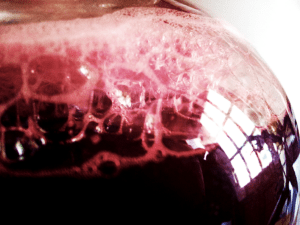 Hello,
Hello,
I am making the Strawberry Zinfandel Niagara Mist, for the first time. I have it in secondary fermentation now. It has 4 more days [before bottling] according to the directions. My question is, how do you know if it’s done? I’m using the glass S shape airlock, but very rarely have seen any bubbles since early the first day. Please help.
Thank you.
Jane
———-
Dear Jane,
It is important to realize that typically 80% of the fermentation activity will be over around the 3rd or 4th day of fermentation. After that, the activity level dramatically tapers off and the fermentation spends the rest of the time fermenting the last 20% of sugars. So, what you are experiencing is close to normal.
Having said this, the only way to really know where your fermentation stands is by testing it with a gravity hydrometer. If you do not have one, I strongly recommend you purchase one right away. As far as homemade wine equipment goes, it’s probably the most important piece you could have.
A gravity hydrometer tells you with an instant test if the wine has any sugars left in it to be fermented or if the sugars are all gone and the fermentation is complete. For more information on the subject, you may want to take a look at the article: “Getting To Know Your Hydrometer” that is on our website.
Best Wishes
Customer Service at E. C. Kraus
———————————————————————————————————
Ed Kraus is a 3rd generation home brewer/winemaker and has been an owner of E. C. Kraus since 1999. He has been helping individuals make better wine and beer for over 25 years.
